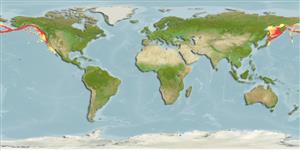Environment: milieu / climate zone / depth range / distribution range
Sinh thái học
Biển Tầng đáy biển sâu; Ở đại duơng, biển (Ref. 51243); Mức độ sâu 175 - 2740 m (Ref. 6793), usually 175 - 1450 m (Ref. 10935). Deep-water; 64°N - 23°N, 141°E - 109°W
North Pacific: Bering Sea coasts of Kamchatka, Russia and Alaska southward to Hatsu Shima Island, southern Japan and Cedros Island, central Baja California, Mexico in the eastern Pacific.
Length at first maturity / Bộ gần gũi / Khối lượng (Trọng lượng) / Age
Maturity: Lm 60.3, range 58 - 62 cm
Max length : 120 cm TL con đực/không giới tính; (Ref. 9988); common length : 80.0 cm TL con đực/không giới tính; (Ref. 9988); Tuổi cực đại được báo cáo: 94 các năm (Ref. 55701)
Các tia vây lưng cứng (tổng cộng): 19 - 27; Các vây lưng mềm (tổng cộng): 16-20; Tia cứng vây hậu môn 3; Tia mềm vây hậu môn: 15 - 19. Dorsal fins well separated; 2nd dorsal fin sub equal to anal fin in size and form, and opposite in position. Reaches over 1 m in SL.
Adults found on mud bottoms, from 305 (Ref. 2850) to 2,740 m depth (Ref. 2850). Young-of-the-year juveniles are pelagic and found on the surface and near-shore waters (Ref. 28499). Generally localized, but some juveniles have been found to migrate over 2,000 miles in 6 or 7 years (Ref. 28499). Feed on crustaceans, worms and small fishes (Ref. 4925). Most of the catch is marketed in Japan (Ref. 28499). Utilized fresh, dried or salted and smoked (Ref. 9988), can be steamed, pan-fried, broiled, boiled, microwaved and baked (Ref. 9988). The liver oil is rich in vitamin A and D (Ref. 4925). Reported to reach 57 kg in Ref. 2850.
Eschmeyer, W.N., E.S. Herald and H. Hammann, 1983. A field guide to Pacific coast fishes of North America. Boston (MA, USA): Houghton Mifflin Company. xii+336 p. (Ref. 2850)
IUCN Red List Status (Ref. 130435)
Threat to humans
Harmless
Human uses
Các nghề cá: tính thương mại cao; Nuôi trồng thủy sản: Giống như cách dùng trong tương lai; Bể nuôi cá: Bể cá công cộng
Các công cụ
Special reports
Download XML
Các nguồn internet
Estimates based on models
Preferred temperature (Ref.
123201): 1.4 - 5.5, mean 2.5 °C (based on 599 cells).
Phylogenetic diversity index (Ref.
82804): PD
50 = 1.2500 [Uniqueness, from 0.5 = low to 2.0 = high].
Bayesian length-weight: a=0.01096 (0.00784 - 0.01533), b=2.99 (2.89 - 3.09), in cm total length, based on LWR estimates for this species (Ref.
93245).
Mức dinh dưỡng (Ref.
69278): 3.8 ±0.2 se; based on diet studies.
Generation time: 5.8 (4.9 - 7.8) years. Estimated as median ln(3)/K based on 23
growth studies.
Thích nghi nhanh (Ref.
120179): Rất thấp, thời gian nhân đôi của chủng quần tối thiểu là hơn 14 năm (K=0.2; tm=6; Fec=100,000; tmax=94).
Prior r = 0.11, 95% CL = 0.06 - 0.16, Based on 5 stock assessments.
Fishing Vulnerability (Ref.
59153): Moderate to high vulnerability (49 of 100).
Climate Vulnerability (Ref.
125649): High vulnerability (58 of 100).
Nutrients (Ref.
124155): Calcium = 16.1 [9.1, 38.6] mg/100g; Iron = 0.46 [0.23, 0.90] mg/100g; Protein = 17 [16, 18] %; Omega3 = 0.567 [0.254, 1.631] g/100g; Selenium = 32.5 [14.5, 79.2] μg/100g; VitaminA = 8.27 [1.99, 36.01] μg/100g; Zinc = 0.27 [0.18, 0.42] mg/100g (wet weight);
